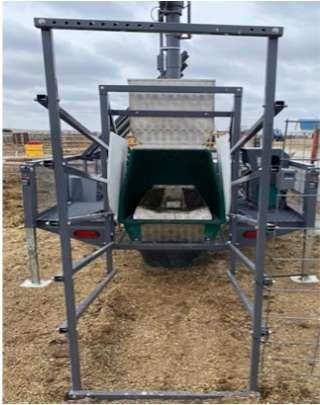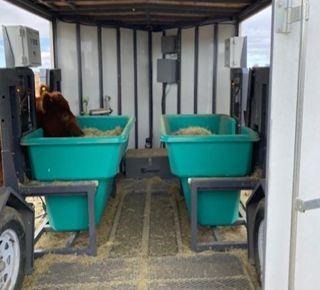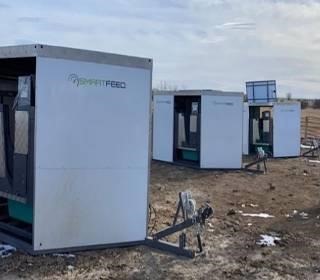By Hector Menendez
Training the First Generation of Extensive Rangeland Precision Ruminant Nutritionists
Lily Jane McFadden is a first-year master’s student from Killdeer, North Dakota. Lily is learning the basics of rangeland nutrition and how to improve cattle production efficiency through the integration of multiple precision technologies and big-data analytics. Further, Lily is assessing the environmental impact of cover cropping systems and livestock by quantifying changes in soil carbon (%) and enteric measurements (methane). After getting her masters she intends to work with producers on improving rangeland nutrition and supplementation programs. She is currently conducting her research at the South Dakota State University (SDSU) Cottonwood Field Station. She is supervised by Dr. Menendez, Olson, Ehlert, Brennan and Blair.

Figure 1. A cow’s perspective of walking into the chamber to receive pellets.
Methane and Dry Matter Intake Trial: Dry Beef Cows in Western S.D.
Greenhouse gases (GHG) are produced by the microbes in the rumen and then belched out into the atmosphere. Greenhouse gases are made up of methane (CH4), nitrous oxide (N2O) and carbon dioxide (CO2), which harms the Earth’s ozone layer. Aside from environmental impacts, increased GHG production indicates energy loss during the rumen fermentation process that could have gone to the animal, essentially losing value on feed. However, there may be a silver lining for using cattle GHG production to advance research and cattle production efficacy.
During the winter of and spring of 2022 (February to May), precision technologies were implemented at the Cottonwood Field Station to 1) Measure daily dry matter intake (DMI), cattle weight (lb./day), and enteric emissions (CH4), and 2) Develop a precision system model (“PSM”; Menendez et al., 2022) to predict the DMI of grazing dry beef cows in western South Dakota using enteric emissions data. The integration of utilizing three precision technologies at the same time for this study is a cutting-edge research approach on extensive rangelands.

Figure 2. A cow at the Cottonwood Field Station using the GreenFeeder.
GreenFeed Pasture System
We deployed the GreenFeed Pasture System (C-Lock Inc. Rapid City, South Dakota), the precision technology to measure individual methane and carbon dioxide emissions, with the help of radio frequency identification (RFID) technology. We can link those measurements with specific animals at a specific event.
The GreenFeed disperses a small amount of pellets at various time intervals to attract cattle and to keep their head in the chamber (Figure 1 and Figure 2) to get averages of enteric emissions measurements. Enteric emissions are methane, nitrous oxide and carbon dioxide that is eructated; this process happens because of fermentation in the rumen when microbes breakdown plant materials, such as fiber, sugars and starches.

Figure 3. Cow at Cottonwood Field Station consuming chopped hay in the SmartFeed Pro. The amount of hay consumed is recorded in real-time.
SmartFeed Pro
Another piece of technology that was implemented in this trial was the SmartFeed Pro (C-Lock Inc. Rapid City, South Dakota). This feeder is designed for cattle of any age or size. With the SmartFeeder Pro, we were able to measure intake by disappearance for each individual animal (Figure 3).
Measuring by disappearance means that we can use RFID technology to see how much each individual cow is consuming each time she eats. For example, if a cow puts her head in and the scanner reads her RFID at the beginning and links it to 400 lbs. of hay in the bunk and, once she pulls her head out, the scanner reads it at 390 lbs. in the bunk, we can then calculate that she consumed 10 lbs. of hay at the time of her visit. The feeders can also be programmed to control intake of each animal daily; for this trial, intake was not limited. Figure 4 shows the three trailers that house two SmartFeed Pro bunks each, enabling these technologies to be deployed more easily.

Figure 4. SmartFeed Pro trailers that house the SmartFeed Pro bunks.
How can this help producers?
Developing an equation to predict dry matter intake (DMI) of grazing cattle has a large potential benefit for producers with their day-to-day decisions. For producers, DMI is important for stocking rates, determining nutrient requirements and evaluating feed efficiency. The ability to predict DMI on the long-term grazing study at the Cottonwood Field Station will allow refinement of stocking rates for beef cows on different qualities of rangeland. For example, most rangeland stocking rates are based of percent body weight (see SDSU grazing calculator), such as 2.5 to 3% for mature cows, meaning that a 1000 lb. cow would need to consume 25 to 30 lbs. of forage per day. The new DMI information that will result from this study can give producers a more-precise stocking rate for their beef cows on winter range using a range of low to high quality of forage, including supplementation considerations (See Heifer Development with Precision Supplementation).
Currently, the GreenFeed is expensive and time consuming, making it impractical for most producers to use. However, the continued research efforts of the SDSU precision livestock team will help producers identify and adopt precision livestock solutions, especially as precision livestock technologies become more viable and affordable.
Source : sdstate.edu